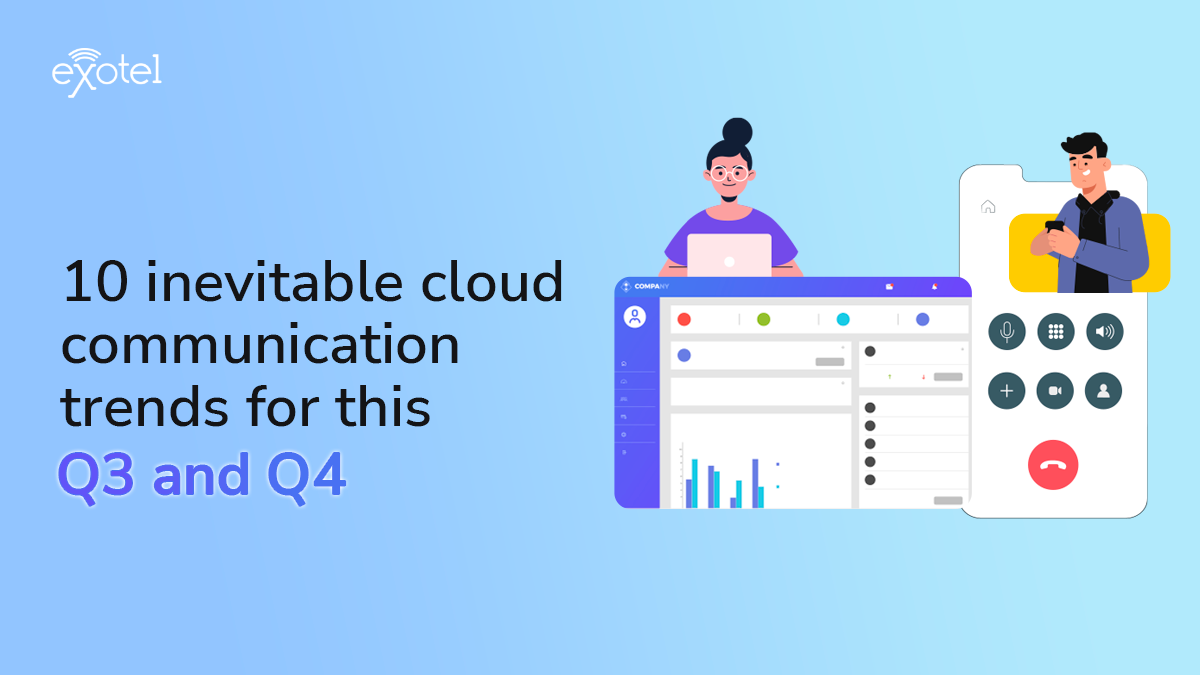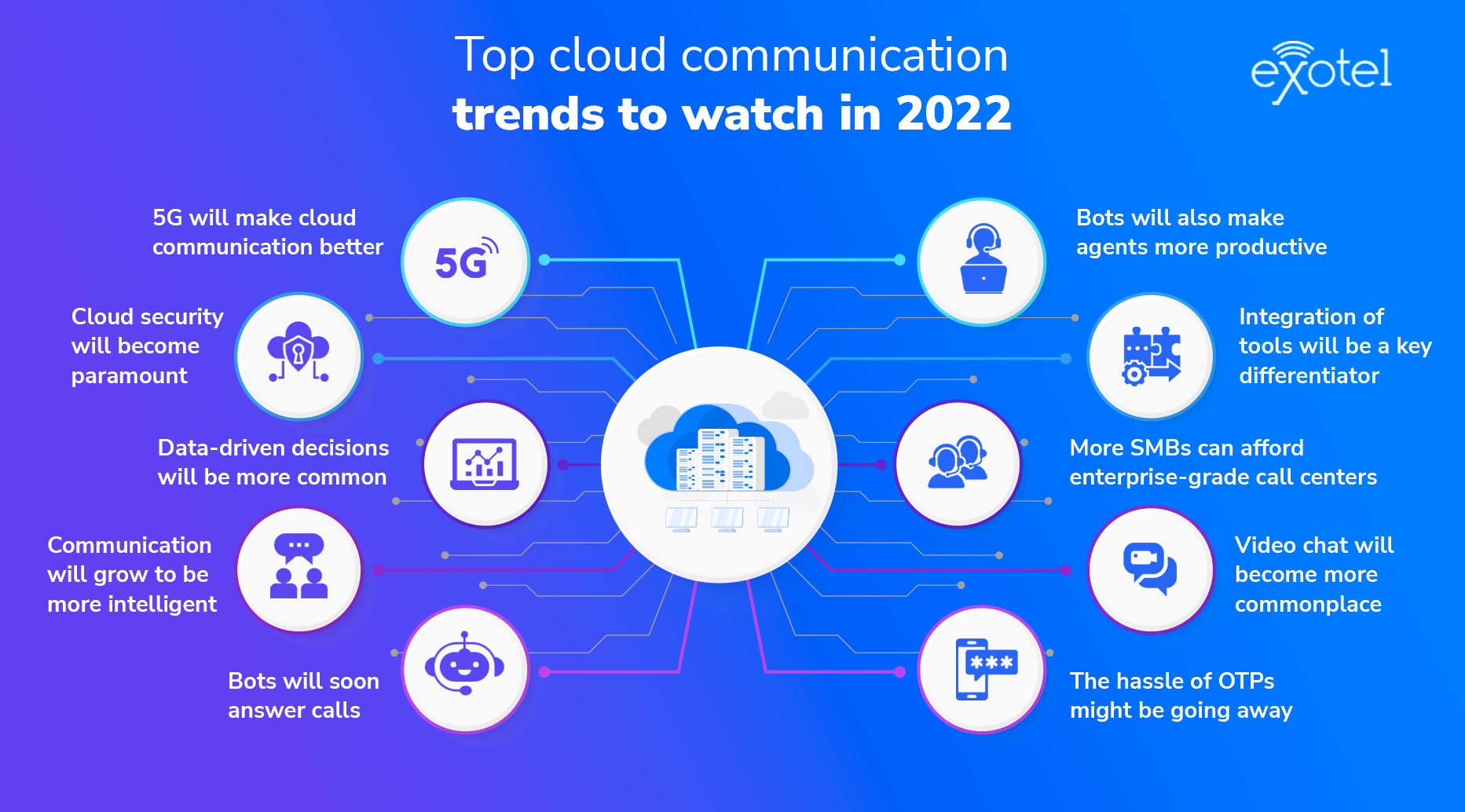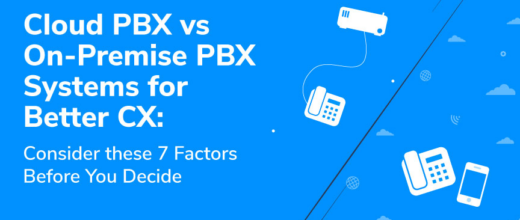A recent study found that the cloud communication platform is set to witness exponential growth between 2020-2030. The truth is that cloud communications saw widespread adoption much before the pandemic.
The scalability, reliability, and affordability offered by cloud telephony are unparalleled. The pandemic, however, accelerated adoption by forcing global workforces to work remotely.
It has been two years since the pandemic began, and the place of cloud communication in the business world has only strengthened. This blog post looks at the emerging trends in cloud communications and how they will impact future businesses. But first:
What is cloud communication?
Cloud communication is the use of the internet for voice and text-based interactions. Here, all the telecommunications applications, switching, and storage are hosted on the cloud, significantly reducing both capital expenditures on infrastructure and regular operations costs.
Top cloud communication trends to watch in 2022
#1 5G will make cloud communication better
Global 5G adoption hits 1 billion in 2022. More and more countries across the globe are building 5G infrastructure to improve communication quality. It is expected to eliminate call jitter, offer better video quality, and reduce call drops. (Source: Statistics)
#2 Cloud security will become paramount
In 2021, a data leak resulted in the personal data of more than 100 million Android users being exposed due to misconfigured cloud services. As cloud adoption increases, the security risks multiply. Reports show that cybercriminals can penetrate 93% of company networks. Governments too are growing stricter in enforcing penalties for lax security measures.
Therefore, in 2022, security will become an important factor in evaluating cloud communications providers.
#3 Data-driven decisions will be more common
While thinking of call centers and SMS services, few organizations consider analytics capabilities. In 2022, that will change. As budgets get tighter and pressure on returns increases, more organizations will demand analytics and reporting for their call centers.
Call recording, call history, missed call alerts, agent productivity, SMS delivery rates, etc., will become critical in designing customer experience.
#4 Communication will grow to be more intelligent
The global call center AI market size is projected to grow 2.5x to over $4 billion by 2027. Cloud communications providers will add more ‘intelligence’ capabilities to their offerings, allowing businesses to automate and scale their customer support. This might include intelligent call routing, dynamic IVRs, automated call recording, etc. (Source: Marketsandmarkets)
#5 Bots will soon answer calls
So far, chatbots have been able to handle the text-based communication needs of an organization. Soon, that is about to come to voice calls as well. Gartner recently predicted that by 2022, 20% of all customer service calls would be handled by AI-powered bots. This means that many customers’ regular queries and needs can be automated, freeing agents only to handle complex or niche requests.
#6 Bots will also make agents more productive
At any call center, agents spend most of their day looking for information, consulting colleagues, jumping from one window to another, etc. With the introduction of bots within the cloud communications tech stack, agents can treat them like their personal assistants, who can find the information they need in a jiffy!
#7 Integration of tools will be a key differentiator
Companies now use an average of 976 applications, with only 28% of these being integrated. And 40% of companies see application integration as one of their top challenges. This creates scattered information, which reduces agent productivity, efficiency, and, eventually, customer satisfaction. So, while evaluating cloud communications technology, organizations will look for software that integrates with their existing tech stack.
#8 More SMBs can afford enterprise-grade call centers
India alone has over 61,400 startups. But not all of them can afford an enterprise-grade call center today as it comes with insane capital expenditure. Cloud communications eliminate that problem. With pay-as-you-go plans and dynamic scalability, cloud telephony allows even small businesses and startups to set up call centers quickly and efficiently.
#9 Video chat will become more commonplace
The pandemic brought in video chat for tasks that were typically done in person, like opening an account or completing KYC formalities. With regulations loosened up, video chat will gain more popularity. Call center software will have built-in video chat functionality or easy integrations with tools like Zoom or Skype for video.
#10 The hassle of OTPs might be going away
Today, most online transactions are authenticated using a one-time password (OTP), typically sent as an SMS to the user. While this is secure and convenient, it is also a hassle to wait for OTPs and enter across devices every time a user needs to be authenticated.
Enter nOTPs. Without sending an OTP, the cloud telephony provider can authenticate users’ phone numbers by intercepting and rejecting a call from their servers. This model will gain popularity, making authentication easier and more cost-effective.
2020 is the year when cloud communication has matured significantly. Enterprises are transitioning from traditional on-prem PBX systems to modern cloud telephony. On the other hand, small businesses are increasingly setting up smaller, more efficient call centers for their growing needs. Cloud communications providers are upping the game by offering innovative features and AI-driven efficiencies.
If you’d like to see how a cloud communications platform can transform your business, Try Exotel today.




 +91-8088919888
+91-8088919888 +61-2-8073-0559
+61-2-8073-0559 +62-215-098-4960
+62-215-098-4960 +60-3-2771-2799
+60-3-2771-2799 +65-6951-5460
+65-6951-5460